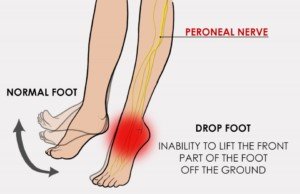
Would any degree of foot drop from ALS or MS be detected when driving and using the gas and brake pedals?
First, what exactly is foot drop?
It’s when a problem involving the peroneal nerve in the lower leg reduces activation of the muscles that this nerve controls: the ones responsible for ankle movement.
More specifically, the ankle movement here would be the ability to move the ankle up (flex), as you would when trimming your toenails or putting on socks.
In foot drop, the ability to even maintain a neutral position (90 degree angle between the lower shin and the top of the foot) is impaired.
The foot becomes limp; it drops. This can be described as a dragging when the patient is walking.
The drop may be very evident even when the patient is sitting on the floor with both legs straight out in front. The affected foot cannot be held upright (toes directed at ceiling).
Along with ALS and MS, this condition has many other causes including sciatica, a herniated lumbar disc, lumbar cyst and chronic irritation of the peroneal nerve from sitting cross-legged.
Driving with Mild Foot Drop
“Foot drop could interfere with driving or possibly prohibit driving depending on the severity,” says Mitzi J. Williams, MD, clinical neurologist with Morehouse School of Medicine, an MS specialist and clinical advisor for the Multiple Sclerosis Foundation.
In multiple sclerosis or ALS, “Foot drop is due to nerve damage that usually is related to lesions in the spinal cord,” says Dr. Williams.
“When a person cannot effectively raise their foot due to weakness, it would make it difficult to move between the pedals quickly when driving.
“If the symptom is mild, it would not interfere with driving.”
However, if the foot drop is due to early stage ALS, it will get worse and definitely become noticeable – not just while driving but while walking, using stairs, going up on one’s toes, putting on shoes and trimming toenails.
If MS is the cause, a foot drop may or may not be severe, but Dr. Williams says, “MS foot drop can also progress, but much more slowly over time.
“Foot drop with MS can also temporarily worsen as the muscles ‘tire out’ with prolonged activity (i.e., if someone does a lot of walking or activity and then gets in the car to drive, their foot drop may be more pronounced, but this will improve with rest.
“MS is a a progressive condition over time, but the progression can occur over 10-20 years vs. the rapid progression of ALS.”
When the cause of a foot drop does not involve a degenerative neurological disease, the situation will not keep getting worse.
With ALS, the drop will progress to the point where the patient requires a special custom-made device (ankle foot orthotic) to support the joint when walking.
As mentioned, multiple sclerosis won’t always lead to this degree of impairment.
Severe Foot Drop and Driving
Dr. Williams says that if it’s “severe and present in their driving foot, then it could make operating a vehicle unsafe.”
Many healthy people who believe they have foot drop will never lose their ability to operate their car, walk or go up on their toes, etc.
The imagined foot drop (perceived weakness) will always remain mild; it will never progress.
As time goes on with zero progression of what they fear is a neurological disease (namely ALS or MS), the perceived weakness typically subsides.
This is because when ALS causes foot drop, other symptoms will always begin presenting – and there will be no remission, only a worsening.










































